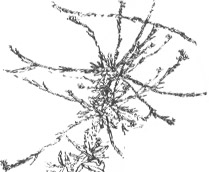 |
Hedge MustardWednesday 27th September 2000, West Yorkshire |
![]()
![]()
![]()
![]()
![]() Nature
Diary Rocks
History
Workshop
Links
Home Page
Nature
Diary Rocks
History
Workshop
Links
Home Page
![]()
 GROWING KNEE-HIGH by the pavement, Hedge Mustard, Sisymbrium officinale, looks to me like a small green barbed wire entanglement. The seed pods, which are aligned along the stem, are pointed, although they're not sharp to the touch. The branches stick out almost at right angles.
GROWING KNEE-HIGH by the pavement, Hedge Mustard, Sisymbrium officinale, looks to me like a small green barbed wire entanglement. The seed pods, which are aligned along the stem, are pointed, although they're not sharp to the touch. The branches stick out almost at right angles. Those tiny yellow flowers at the end of the stems are cross-shaped; a clue that this flower is a Crucifer, and, as the name suggests, a member of the Mustard family. In the 17th century both the English herbalist Culpepper and the French dramatist Racine recommended it as a treatment for a lost voice. Culpepper wrote that it 'is good in diseases of the chest and lungs, and hoarseness; by the use of the decoction lost voice has been recovered.
Those tiny yellow flowers at the end of the stems are cross-shaped; a clue that this flower is a Crucifer, and, as the name suggests, a member of the Mustard family. In the 17th century both the English herbalist Culpepper and the French dramatist Racine recommended it as a treatment for a lost voice. Culpepper wrote that it 'is good in diseases of the chest and lungs, and hoarseness; by the use of the decoction lost voice has been recovered.It grows on waysides and on waste ground.
![]()
Richard Bell,
wildlife illustrator
E-mail; 'richard@willowisland.co.uk'
![]() Next page
Previous page
Nature Diary
Wild
West Yorkshire home page
Next page
Previous page
Nature Diary
Wild
West Yorkshire home page
![]()